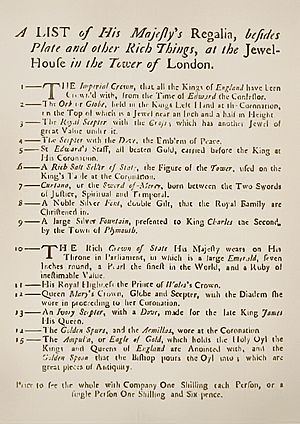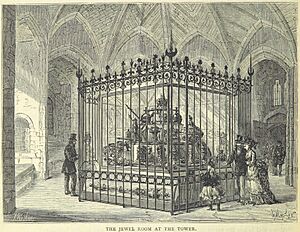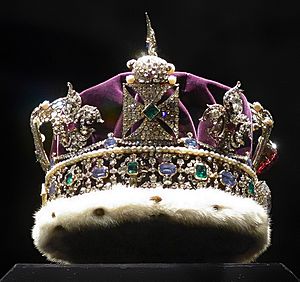Jewel House facts for kids
The Jewel House is a special vault inside the Tower of London. It's where the amazing Crown Jewels of Britain are kept safe. This building is part of the Waterloo Block, which used to be a place for soldiers. Queen Elizabeth II opened the Jewel House in 1994, and it was updated in 2012 to make it even better. The Crown Jewels have been stored in different parts of the Tower since the 1300s, especially after some attempts to steal them from Westminster Abbey.
History of the Jewel House
Early Days: Before the 1600s
A person in charge of the Crown Jewels was first appointed way back in 1207. Over many years, this person had different job titles, like "Keeper of the King's Jewels." Their main job was to look after the important royal treasures.
Even though there was a treasury (a place for valuable things) in the Tower of London for a very long time, a separate Jewel House was built in 1255 near Westminster Abbey. This was specifically for state crowns and other royal items.
In 1378, the keeper gained more control over the royal jewels. They kept them in a special box with two keys, one for themselves and one for the Lord Treasurer. This was the start of the Jewel House Department. Most royal treasures were usually kept at the Tower of London. Also, items used for coronations were often kept in the Chamber of the Pyx at Westminster Abbey.
After someone tried to rob the Chamber of the Pyx in 1303, some of the royal items were moved to the Tower of London to be safer. A new Jewel House was built near the White Tower in 1378. In the 1530s, this Jewel House was rebuilt, and all the jewels and royal plates were brought together there.
From 1660 to 1814: Public Displays and a Daring Attempt
After the monarchy was brought back in 1660, the Crown Jewels started to be shown to the public. This became a very important part of the Jewel House's job.
In 1669, the jewels were moved to a new room in the Martin Tower. A person named Talbot Edwards would show the jewels to visitors for a small fee. This was a very informal way of doing things.
However, in 1671, a man named Colonel Thomas Blood tried to steal the Crown Jewels! He overpowered the person guarding them and, with his helpers, tried to run off with the jewels. Luckily, all the items were recovered, though some were a bit damaged. For example, St Edward's Crown was squashed, and the Sovereign's Orb got a dent.
After this incident, big changes were made. An armed guard was put in place, and the collection was moved behind bars in a room with no windows. The first guidebook about the Crown Jewels was also published, making it a formal visitor attraction. People could only see the jewels from a distance, but for a small fee, they could reach through the bars and touch some of them.
In 1782, the main Jewel Office department was closed down. From 1782 to 1814, only a caretaker lived at the Tower to guard the jewels. In 1814, a new Keeper of the Jewel House was appointed.
From 1815 to 1966: Better Displays and New Buildings
In 1815, a visitor damaged the State Crown. This, along with the poor living conditions for the keeper, led to big changes in 1816. A rail was put up to keep visitors further away from the jewels. The repaired State Crown and other items were placed in glass cases on tables that could spin. Bright lamps were also installed to light up the collection.
By the 1830s, showing the jewels was a very profitable business. The keeper earned a lot of money from visitor fees. Because of this, new plans were made to build a special new building at the Tower of London just for the collection. This new building opened in 1842.
The Crown Jewels were displayed in glass cases in the middle of a room with large windows, so people could walk around and see them clearly. In 1852, the keeper officially became a member of the Royal Household and received a fixed salary. However, the new Jewel House building was thought to be a fire risk. So, a new room was built on the upper floor of the Wakefield Tower in 1868. The Crown Jewels stayed there until 1967, except when they were moved temporarily during wars or for special ceremonies.
From 1967 to 1993: A Modern Vault
After the Second World War, the 19th-century Jewel House wasn't secure enough and couldn't handle the large number of visitors. At busy times, 1,500 people a day came to see the jewels.
A new Jewel House was built in 1967 in the Waterloo Barracks. It cost £360,000 and was designed to handle up to 5,000 visitors a day. The very valuable coronation items were kept in an underground vault. Other items, like trumpets and maces, were displayed on the ground floor. Visitors would walk down 49 steps to enter the concrete vault, which was said to be strong enough to protect the jewels even from a nuclear attack. The jewels were in a large star-shaped case, and visitors walked around it. A raised viewing area allowed people to see the collection more slowly.
In 1968, a new group of wardens was created to protect the jewels. The job of Keeper of the Jewel House was combined with the Resident Governor of the Tower of London. In 1990, the Jewel House and the Tower of London became the responsibility of a new group called Historic Royal Palaces.
From 1994 to 2011: A New Look
By the 1980s, up to 15,000 people visited the jewels every day, leading to long queues. The display also started to look old-fashioned. So, in 1992, it was decided to build a brand new Jewel House on the ground floor of the building. This new project cost £10 million. Ideas for the layout and presentation were taken from places like Disneyland and other jewel houses in Europe.
Queen Elizabeth II officially opened the new Jewel House on March 24, 1994. It takes up almost the entire ground floor of the Waterloo Block. It was designed to allow up to 20,000 people a day to see the collection. This collection includes more than 100 priceless objects and over 23,578 diamonds, rubies, emeralds, and sapphires. The jewels were lit by modern fibre optics and rested on soft French velvet.
Some people felt the experience was mainly about managing crowds, even though it was beautifully lit and presented. They noted the very thick, heavy steel doors and the use of a moving walkway during busy times.
Present Day: An Updated Experience
In 2012, the exhibit was updated again with a £2.5 million revamp. This included a new introduction area with a video. The video shows the history of the Crown Jewels and explains how they are used in the coronation ceremony.
The jewels themselves are now displayed in the order they are used during a coronation. As visitors walk through the exhibition, they can hear Handel's famous coronation anthems. Brighter lights were installed to make the jewels look more natural. A new lift was also added to help visitors with disabilities reach the viewing platform. The Princess Royal officially reopened the Jewel House on March 29, 2012.
The underground vault that was built in 1967 is now used to store 25,000 architectural drawings of historic royal palaces.
Security at the Jewel House
The Crown Jewels are protected by very strong, bombproof glass. Visitors to the Tower are also watched closely by more than 100 hidden CCTV cameras. The overall security of the Tower of London is handled by the 22-person Tower Guard. This group of soldiers from the British Army has been at the Waterloo Block since 1845. They follow special orders to make sure the Crown Jewels are safe.
The 38 Yeomen Warders, who are former military personnel, also help with security. However, during the day, their main job is to help manage the large number of visitors. Unlike the soldiers, the Yeomen Warders live permanently at the Tower. This group has been around since 1485.
The jewels can only be removed with permission from the Lord Chamberlain, who is the head of the Royal Household. Only the Crown Jeweller is allowed to handle the royal items. Armed police officers are always present when the jewels are being moved or handled. In 2011, Colonel Richard Harrold was appointed as the Keeper of the Jewel House. As of May 2023, Brigadier Andrew Jackson was the Keeper. He even took part in the Royal Procession during the Coronation of Charles III and Camilla, carrying the King's ring.
The Chief Exhibitor of the Jewel House is Keith Hanson, and the Deputy Chief Exhibitor is Lyn Jones.
See also
- Jewel Tower, another historic place where royal treasures were kept near the Palace of Westminster.







